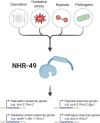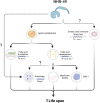Nuclear hormone receptor NHR-49 is an essential regulator of stress resilience and healthy aging in Caenorhabditis elegans
- PMID: 37645565
- PMCID: PMC10461480
- DOI: 10.3389/fphys.2023.1241591
Nuclear hormone receptor NHR-49 is an essential regulator of stress resilience and healthy aging in Caenorhabditis elegans
Abstract
The genome of Caenorhabditis elegans encodes 284 nuclear hormone receptor, which perform diverse functions in development and physiology. One of the best characterized of these is NHR-49, related in sequence and function to mammalian hepatocyte nuclear factor 4α and peroxisome proliferator-activated receptor α. Initially identified as regulator of lipid metabolism, including fatty acid catabolism and desaturation, additional important roles for NHR-49 have since emerged. It is an essential contributor to longevity in several genetic and environmental contexts, and also plays vital roles in the resistance to several stresses and innate immune response to infection with various bacterial pathogens. Here, we review how NHR-49 is integrated into pertinent signaling circuits and how it achieves its diverse functions. We also highlight areas for future investigation including identification of regulatory inputs that drive NHR-49 activity and identification of tissue-specific gene regulatory outputs. We anticipate that future work on this protein will provide information that could be useful for developing strategies to age-associated declines in health and age-related human diseases.
Keywords: GLP-1; HNF4; PPAR; fatty acid desaturation; fatty acid β oxidation; longevity; nhr-49; stress response.
Copyright © 2023 Doering, Ermakova and Taubert.
Conflict of interest statement
The authors declare that the research was conducted in the absence of any commercial or financial relationships that could be construed as a potential conflict of interest.
Figures



References
Publication types
LinkOut - more resources
Full Text Sources

